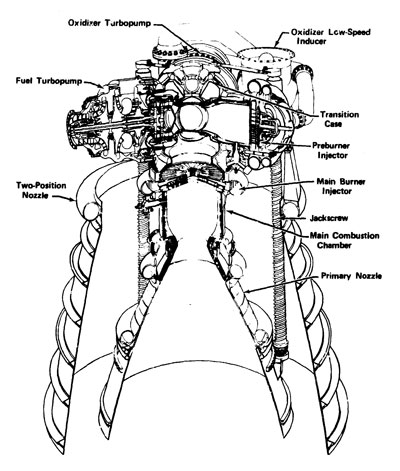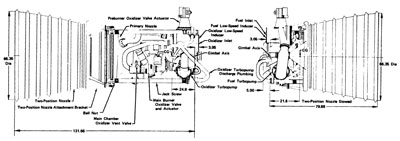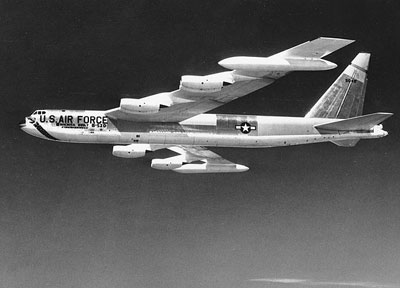A bat outta Hell: the ISINGLASS Mach 22 follow-on to OXCARTby Dwayne Day
|
| By the mid-1960s the CIA began looking at a potential replacement for the OXCART, a Mach 22 rocket-powered glider known as ISINGLASS. |
According to James Cunningham, the CIA’s Director of the Developmental Projects Division, or DPD in the 1960s, who had been involved in the U-2, A-12 and other reconnaissance aircraft programs in the 1950s and 1960s, ISINGLASS started out as a proposal from McDonnell Douglas. The company came to the CIA one day and said, “Hey, what do you guys think of this?” Cunningham remembered. “Do you think this would float?”
What McDonnell Douglas was pitching was a manned craft that would be dropped from a B-52, light a rocket engine, and climb, zooming to nearly-orbital speed and sailing over the Soviet Union at such high altitude that nothing could touch it. As Cunningham remembered it, the craft was supposed to be powered by a Pratt & Whitney engine, although he misremembered the model number.
Cunningham said that he and CIA officials Jack Ledford and John Parangosky met with Jim McDonnell and his son to discuss the project. This was most likely in early 1965. The CIA did not have any money, so McDonnell agreed to self-fund the project. “They said they’d put in $10 million and they would go as far as that money would take them,” he explained. In return, the CIA would provide the company with technical support learned from the OXCART program, such as information on how to design camera windows in a high-speed environment.
Cunningham explained that the flight profile for ISINGLASS would be unlike anything ever built before. “It would be launched, say, off the coast of Spain. It would promptly ascend to 125,000 feet [38,100 meters] under throttling, and you’d point it in the general direction of east, let’s say, and pour the coal to it, and then shut it off. It would go tootling along at roughly Mach 22,” just below orbital velocity, he said. “You’d take yourself all kinds of pictures all the way across Russia,” and then recover at a classified location, probably Groom Lake in the Nevada desert. “Damn near circumnavigate the globe, you know,” Cunningham added.
The plan was to build a total of eight aircraft, three intended for flight testing. The development project would take about five years, with the craft becoming operational around 1971 and capable of operating for about five years.
Mysterious bird
Cunningham described ISINGLASS as looking “like a scaled-down space shuttle,” but its exact shape has not been declassified, although it had to be small enough to fit under the wing of a B-52. It is still not clear from available documentation if ISINGLASS used drop tanks, although dumping them over land would have been a major operational problem. The vehicle would have skids for landing gear, like the X-15, and land on a conventional 3,000-meter (10,000-foot) runway. It was designed for an unpowered landing, although for short missions Cunningham said that it might be possible to bring it in under rocket power.
McDonnell Douglas worked on the project for approximately 14 months. “They built a third-scale cross-section of this thing,” he said, “showing what they could do in a metallurgical sense, because it had all kinds of exotic metals in it, you know, heat-reflecting materials—columbium and all these other weird things that you don’t see on the grocery shelves.”
With so much of the company’s money invested in their work, McDonnell Douglas made a serious proposal to the National Reconnaissance Office to build ISINGLASS, even detailing who would work on the project if they received a development contract. Harold Altis, who later became a senior manager at the company, served as the project manager. The CIA provided clearances for 200 McDonnell Douglas employees to work on ISINGLASS. “We thought it was a pretty good idea, because McDonnell Douglas did an excellent job. They did their homework like nobody’s business.”
| Cunningham described ISINGLASS as looking “like a scaled-down space shuttle,” but its exact shape has not been declassified. |
Although the CIA couldn’t provide funding, the Air Force did provide money to develop an engine for ISINGLASS. It was a true monster for its time, known as the XLR-129. The XLR-129 was powered by hydrogen and oxygen and rated at 1.11 million newtons (250,000 pounds) of thrust. (Cunningham’s confusion over the model number—he referred to it as the RL-20 and said that it was used on the Saturn rocket—may be due to him confusing it with the Saturn’s J-2 engine, which was rated at 1.03 million newtons (232,000 pounds) of thrust and also a hydrogen-oxygen engine in the same category as the XLR-129.) Several years ago former senior CIA official Albert “Bud” Wheelon mentioned that ISINGLASS was a pet project of Air Force Systems Command leader—and father of the American ICBM—General Bernard Schriever. Schriever probably lacked the ability to fund a reconnaissance spaceplane, but could fund a rocket engine.
There were a couple of unique aspects to the XLR-129. One was that it was designed for reusability. The other was that it was equipped with a unique two-position nozzle that extended at high altitude. The contract was intended to cover a 54-month period, from November 1967 until May 1972. Engineers evaluated the possibility of using fluorine as an oxidizer, but this doubled the program cost. The XLR-129 never finished development, although many of its key subsystems were tested. The program was redirected to a demonstration of critical components and completed in August 1970. The XLR-129 served as the basis, in uprated form, for Pratt & Whitney’s losing Space Shuttle Main Engine proposal in the early 1970s. But the redirection toward component-level demonstration, according to a Pratt & Whitney report, “was accomplished to avoid duplicating work performed on the NASA Phase B Space Shuttle Main Engine (SSME) studies.” Pratt & Whitney employees later claimed that they were told to destroy their blueprints and test data to “avoid embarrassing NASA.” Pratt & Whitney engineers obviously felt they had a superior product, but what happened to it and why probably requires further investigation.
  Pratt & Whitney developed the XLR-129 engine, a LOX/H2 engine with 250,000 pounds of thrust. It was designed to be reusable and had a two-position nozzle and extended via use of jackscrews. (Source: Department of Defense) |
The sound of one hand clapping
When the CIA and the National Reconnaissance Office were evaluating ISINGLASS to replace the OXCART and Blackbird, they did not discuss the Mach 22 rocket-glider in terms of surprising targets, but in terms of quick-response and rapid turnaround. Spysats took days to prepare for launch, and those already in orbit might take days to get into position. They also used film-recovery techniques that required days to return useable film to eyeballs in Washington. ISINGLASS, in contrast, could be launched when needed and return quickly, and its film could reach the interpreters much faster. At least that’s what the advocates claimed.
The problem was that there was no official requirement for such a capability. In the mid-1960s there was a process in place for the intelligence community to state what it needed and then translate these requirements into systems such as aircraft and satellites to fulfill that need. Sometimes clever engineers helped to shortcut the process by demonstrating that they could do something amazing and the intelligence users decided that they needed this capability. In the case of ISINGLASS, McDonnell Douglas pitched the system and the CIA was interested, but did not have the money. And they were soon to get the sticker-shock.
| “ISINGLASS showed great promise,” Cunningham said. “Virtually unstoppable.” |
According to Cunningham, as McDonnell Douglas completed their preliminary design work “it was then in shape to talk seriously about going into production.” So the CIA prepared a pitch for the Bureau of the Budget, the President’s office in charge of drafting a federal budget. “Well, of course, the bill was, by anybody’s standards, pretty staggering. It was like the eight vehicles were spaced out over three years and the total cost was like $2.6 billion. And this was in 1965 dollars.” (Roughly $18 billion in 2010 dollars.) “It got a very polite reception, like everybody in the audience clapped with one hand.”
McDonnell Douglas took the ISINGLASS proposal to the Air Force, but according to Cunningham they were uninterested because it was a “not-invented-here” idea. “They didn’t even want to hear it, basically.” The project died in 1967 or soon thereafter, although Pratt & Whitney’s engine work continued. A brief Air Force effort to resurrect ISINGLASS occurred near the end of 1968, but it failed.
Virtually unstoppable
Despite the chilly reception, even decades later Cunningham was impressed. “ISINGLASS showed great promise,” he said. “Virtually unstoppable.” Late in the project, probably even after it was clear that the government was not going to fund it, they conducted a simulation of ISINGLASS against several types of Soviet air defense threats, including the Galosh anti-ballistic missile, the SA-5 high-altitude SAM, and even a theoretical advanced missile that they dubbed “Missile X.” Even when the Soviet missiles were equipped with nuclear warheads they were useless against ISINGLASS, although they might limit its flight profile. “In other words, you couldn’t shoot it down with an SA-anything,” Cunningham bragged.
ISINGLASS did have its limitations, however. “You’d probably get all kinds of protests and there was always the concern that maybe they might think this was the big one. But, if you lug it up to their front door in a B-52 and they can watch it take off on radar, it’s a little bit less likely than if something came over the pole. But it’s probably… the kind of thing that would be given very long thought before it was used over the heartland. That doesn’t mean you couldn’t fly over China or someplace, but it’s kind of an expensive way to get coverage, based on what you can get now from satellites.”
In the early 1980s the Air Force Space Command was looking at the possibility of building a manned spaceplane. “Because they’ve got something called a Space Division, they have to have something to fill it. It’s like Parkinson’s law of airplanes,” Cunningham said, referring to the old adage that work expands so as to fill the time available for its completion.
At the time, John Parangosky was consulting for an aerospace contractor and got word of the Air Force’s interest. According to Cunningham, Parangosky heard about the project and got the ISINGLASS files pulled out of storage and “sort of on a disembodied basis” let the Air Force know what would happen if they tried to mate certain kinds of high-temperature metals. “‘Where’d you get that?’ they’d ask. Well, that was research that was done about 1965.”
